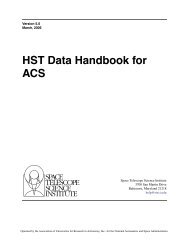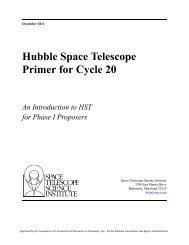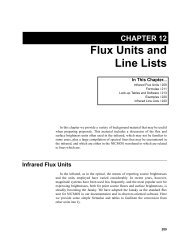- Page 1 and 2: Version 3.0 December 2010 Wide Fiel
- Page 3 and 4: Table of Contents Acknowledgments .
- Page 5 and 6: Table of Contents v 5.5 The WFC3 IR
- Page 7 and 8: Table of Contents vii 7.8 IR Sensit
- Page 9 and 10: Table of Contents ix Appendix C: Di
- Page 11 and 12: xi Past Science IPT Members Elizabe
- Page 13 and 14: CHAPTER 1: Introduction to WFC3 In
- Page 15 and 16: WFC3 Quick Reference Guide 3 • UV
- Page 17 and 18: Sources of Further Information 5 1.
- Page 19 and 20: CHAPTER 2: WFC3 Instrument Descript
- Page 21 and 22: Figure 2.1: Schematic optical layou
- Page 23 and 24: Spectral Elements 11 elongation of
- Page 25 and 26: Spectral Elements 13 Figure 2.3: UV
- Page 27 and 28: Detector Read-Out Modes and Ditheri
- Page 29 and 30: Choosing Between Instruments 17 3.2
- Page 31 and 32: 3.3.2 Field of View Comparison of W
- Page 33 and 34: Comparison of WFC3 with Other HST I
- Page 35 and 36: Comparison of WFC3 with Other HST I
- Page 37: Preparing a Phase I Proposal 25 4.2
- Page 41 and 42: CHAPTER 5: WFC3 Detector Characteri
- Page 43 and 44: The WFC3 UVIS Channel CCD Detectors
- Page 45 and 46: WFC3 CCD Readout Formats 33 5.3 WFC
- Page 47 and 48: WFC3 CCD Characteristics and Perfor
- Page 49 and 50: WFC3 CCD Characteristics and Perfor
- Page 51 and 52: WFC3 CCD Characteristics and Perfor
- Page 53 and 54: WFC3 CCD Characteristics and Perfor
- Page 55 and 56: WFC3 CCD Characteristics and Perfor
- Page 57 and 58: WFC3 CCD Characteristics and Perfor
- Page 59 and 60: WFC3 CCD Characteristics and Perfor
- Page 61 and 62: 5.4.12 Crosstalk WFC3 CCD Character
- Page 63 and 64: The WFC3 IR Channel Detector 51 Fig
- Page 65 and 66: WFC3 IR Readout Formats 53 Figure 5
- Page 67 and 68: WFC3 IR Readout Formats 55 Full-fra
- Page 69 and 70: WFC3/IR Detector Characteristics an
- Page 71 and 72: WFC3/IR Detector Characteristics an
- Page 73 and 74: WFC3/IR Detector Characteristics an
- Page 75 and 76: WFC3/IR Detector Characteristics an
- Page 77 and 78: Specifying a UVIS Observation 65 6.
- Page 79 and 80: UVIS Field Geometry 67 Figure 6.1:
- Page 81 and 82: 6.4.4 Subarrays and On-Chip Binning
- Page 83 and 84: UVIS Field Geometry 71 target at th
- Page 85 and 86: UVIS Spectral Elements 73 6.5 UVIS
- Page 87 and 88: UVIS Spectral Elements 75 Table 6.2
- Page 89 and 90:
Figure 6.3: Integrated system throu
- Page 91 and 92:
Figure 6.5: Integrated system throu
- Page 93 and 94:
UVIS Spectral Elements 81 UV Filter
- Page 95 and 96:
UVIS Spectral Elements 83 Table 6.3
- Page 97 and 98:
UVIS Spectral Elements 85 Figure 6.
- Page 99 and 100:
6.5.3 Ghosts UVIS Spectral Elements
- Page 101 and 102:
UVIS Optical Performance 89 Table 6
- Page 103 and 104:
UVIS Optical Performance 91 Figure
- Page 105 and 106:
UVIS Optical Performance 93 Table 6
- Page 107 and 108:
UVIS Optical Performance 95 Figure
- Page 109 and 110:
UVIS Exposure and Readout 97 (1.0,
- Page 111 and 112:
UVIS Sensitivity 99 contains 1402×
- Page 113 and 114:
6.9.3 Charge-Transfer Efficiency Ot
- Page 115 and 116:
UVIS Observing Strategies 103 6.10
- Page 117 and 118:
CHAPTER 7: IR Imaging with WFC3 In
- Page 119 and 120:
IR Field Geometry 107 The WFC3 IR d
- Page 121 and 122:
IR Field Geometry 109 The POS TARG
- Page 123 and 124:
IR Spectral Elements 111 Table 7.1:
- Page 125 and 126:
Figure 7.2: Integrated system throu
- Page 127 and 128:
IR Spectral Elements 115 Wide-band
- Page 129 and 130:
IR Optical Performance 117 Table 7.
- Page 131 and 132:
IR Optical Performance 119 Figure 7
- Page 133 and 134:
IR Optical Performance 121 Table 7.
- Page 135 and 136:
IR Exposure and Readout 123 Inter-p
- Page 137 and 138:
IR Exposure and Readout 125 • the
- Page 139 and 140:
Table 7.8: Sample times of 1024×10
- Page 141 and 142:
IR Sensitivity 129 Table 7.9: Suppo
- Page 143 and 144:
Other Considerations for IR Imaging
- Page 145 and 146:
Other Considerations for IR Imaging
- Page 147 and 148:
Other Considerations for IR Imaging
- Page 149 and 150:
IR Observing Strategies 137 sub-pix
- Page 151 and 152:
IR Observing Strategies 139 Table 7
- Page 153 and 154:
CHAPTER 8: Slitless Spectroscopy wi
- Page 155 and 156:
Slitless Spectroscopy with the UVIS
- Page 157 and 158:
Slitless Spectroscopy with the IR G
- Page 159 and 160:
Slitless Spectroscopy with the IR G
- Page 161 and 162:
Sensitivities and Exposure-Time Est
- Page 163 and 164:
CHAPTER 9: WFC3 Exposure-Time Calcu
- Page 165 and 166:
Calculating Sensitivities from Tabu
- Page 167 and 168:
Calculating Sensitivities from Tabu
- Page 169 and 170:
Count Rates (Imaging) 157 Table 9.2
- Page 171 and 172:
9.4.2 Diffuse Sources Count Rates (
- Page 173 and 174:
The S/N ratio Σ achieved in exposu
- Page 175 and 176:
Sky Background 163 • I λ is the
- Page 177 and 178:
Sky Background 165 Figure 9.1: Sky
- Page 179 and 180:
Sky Background 167 Table 9.4: Appro
- Page 181 and 182:
Exposure-Time Calculation Examples
- Page 183 and 184:
Exposure-Time Calculation Examples
- Page 185 and 186:
Observatory Overheads 173 activitie
- Page 187 and 188:
Instrument Overheads 175 Table 10.1
- Page 189 and 190:
Instrument Overheads 177 IR paralle
- Page 191 and 192:
Orbit Use Examples 179 In the IR ch
- Page 193 and 194:
Orbit Use Examples 181 Table 10.4:
- Page 195 and 196:
Orbit Use Examples 183 Table 10.6:
- Page 197 and 198:
APPENDIX A: WFC3 Filter Throughputs
- Page 199 and 200:
Throughputs and S/N Ratio Data 187
- Page 201 and 202:
% Throughput 30 25 20 15 UVIS/F200L
- Page 203 and 204:
% Throughput UVIS/F225W Description
- Page 205 and 206:
% Throughput UVIS/F280N Description
- Page 207 and 208:
% Throughput UVIS/F336W Description
- Page 209 and 210:
% Throughput UVIS/F350LP Descriptio
- Page 211 and 212:
% Throughput UVIS/F390M Description
- Page 213 and 214:
% Throughput UVIS/F395N Description
- Page 215 and 216:
% Throughput UVIS/F438W Description
- Page 217 and 218:
% Throughput UVIS/F469N Description
- Page 219 and 220:
% Throughput UVIS/F475X Description
- Page 221 and 222:
% Throughput UVIS/F502N Description
- Page 223 and 224:
% Throughput UVIS/F555W Description
- Page 225 and 226:
% Throughput UVIS/F606W Description
- Page 227 and 228:
% Throughput UVIS/F625W Description
- Page 229 and 230:
% Throughput UVIS/F645N Description
- Page 231 and 232:
% Throughput UVIS/F657N Description
- Page 233 and 234:
% Throughput UVIS/F665N Description
- Page 235 and 236:
% Throughput UVIS/F680N Description
- Page 237 and 238:
% Throughput UVIS/F763M Description
- Page 239 and 240:
% Throughput UVIS/F814W Description
- Page 241 and 242:
% Throughput UVIS/F850LP Descriptio
- Page 243 and 244:
% Throughput UVIS/FQ232N Descriptio
- Page 245 and 246:
% Throughput UVIS/FQ378N Descriptio
- Page 247 and 248:
% Throughput UVIS/FQ422M Descriptio
- Page 249 and 250:
% Throughput UVIS/FQ437N Descriptio
- Page 251 and 252:
% Throughput UVIS/FQ508N Descriptio
- Page 253 and 254:
% Throughput UVIS/FQ619N Descriptio
- Page 255 and 256:
% Throughput UVIS/FQ672N Descriptio
- Page 257 and 258:
% Throughput UVIS/FQ727N Descriptio
- Page 259 and 260:
% Throughput UVIS/FQ889N Descriptio
- Page 261 and 262:
% Throughput UVIS/FQ924N Descriptio
- Page 263 and 264:
% Throughput IR/F098M Description B
- Page 265 and 266:
% Throughput IR/F110W Description W
- Page 267 and 268:
% Throughput IR/F126N Description [
- Page 269 and 270:
% Throughput IR/F128N Description P
- Page 271 and 272:
% Throughput IR/F132N Description P
- Page 273 and 274:
% Throughput IR/F140W Description W
- Page 275 and 276:
% Throughput IR/F160W Description W
- Page 277 and 278:
% Throughput IR /F167N Description
- Page 279 and 280:
Throughputs and S/N Ratio Data 267
- Page 281 and 282:
Throughputs and S/N Ratio Data 269
- Page 283 and 284:
Throughputs and S/N Ratio Data 271
- Page 285 and 286:
Throughputs and S/N Ratio Data 273
- Page 287 and 288:
APPENDIX B: Geometric Distortion In
- Page 289 and 290:
UVIS Channel 277 See http://www.sts
- Page 291 and 292:
IR Channel 279 Figure B.3: Linear c
- Page 293 and 294:
APPENDIX C: Dithering and Mosaickin
- Page 295 and 296:
WFC3 Patterns 283 special-purpose m
- Page 297 and 298:
WFC3 Patterns 285 Table C.3:Steps i
- Page 299 and 300:
APPENDIX D: Bright-Object Constrain
- Page 301 and 302:
IR Channel 289 available. To use th
- Page 303 and 304:
IR Channel 291 Table D.4: Count Rat
- Page 305 and 306:
The STScI Reduction and Calibration
- Page 307 and 308:
The STScI Reduction and Calibration
- Page 309 and 310:
The SMOV Calibration Plan 297 Propo
- Page 311 and 312:
The Cycle 17 Calibration Plan 299 P
- Page 313 and 314:
The Cycle 18 Calibration Plan 301 P
- Page 315 and 316:
Glossary 303 FGS: Fine Guidance Sen
- Page 317 and 318:
Index A ACCUM mode UVIS 96 Aperture
- Page 319 and 320:
Index 307 UVIS/FQ634N 242 UVIS/FQ67
- Page 321:
Index 309 comparing HST instruments







